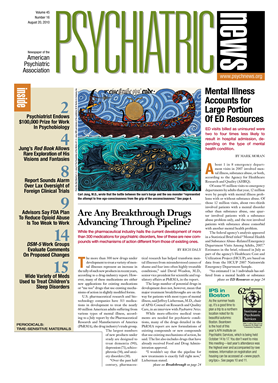About 1 in 8 emergency department visits in 2007 involved mental illness, substance abuse, or both, according to the Agency for Healthcare Research and Quality (AHRQ).
Of some 95 million visits to emergency departments by adults that year, 12 million were by people with mental illness problems with or without substance abuse. Of those 12 million visits, about two-thirds involved patients with a mental disorder other than substance abuse, one quarter involved patients with a substance abuse problem only, and the rest involved patients with substance abuse comorbid with another mental health problem.
The federal agency's analysis appeared in a Statistical Brief titled “Mental Health and Substance Abuse–Related Emergency Department Visits Among Adults, 2007.” Estimates in the brief, released in July as part of the agency's Healthcare Cost and Utilization Project (HCUP), are based on data from the HCUP 2007 Nationwide Emergency Department Sample.
“An estimated 1 in 3 individuals has suffered from a mental health or substance abuse condition within the last 12 months, yet the community treatment system to support services for these individuals is regarded as ineffective,” the authors of the brief stated. “This is particularly evident in emergency department (ED) utilization. The number of patients with mental health and substance abuse (MHSA) conditions treated in EDs has been on the rise for more than a decade. Not only is this of concern to members of the mental health community, but also to the members of the emergency medicine community who are concerned that ED overcrowding results in decreased quality of care and increased likelihood of medical error.”
The brief presents a wide range of data about ED visits for MHSA conditions, including rates of various presenting conditions and patient and payer characteristics. Here are some of the key findings:
•.
MHSA-related ED visits were two-and-a-half times more likely to result in hospital admission than ED visits related to non-MHSA conditions—nearly 41 percent of MHSA-related ED visits resulted in hospitalization.
•.
Medicare was billed most frequently for MHSA-related ED visits (30.1 percent), followed by private insurance (25.7 percent), and Medicaid (19.8 percent); 20.6 percent of such visits had no insurance coverage.
•.
Visits related to mental health conditions without substance abuse accounted for 63.7 percent of all MHSA-related ED visits. Substance abuse conditions accounted for 24.4 percent of all MHSA-related ED visits, and co-occurring MHSA conditions accounted for 11.9 percent.
•.
ED visits billed as uninsured were two to four times less likely than those covered by insurance to result in hospital admission, depending on the type of MHSA condition.
•.
Mood disorder was the most common MHSA-related reason for an ED visit (42.7 percent), followed by anxiety disorders (26.1 percent) and alcohol-related conditions (22.9 percent). The remaining common conditions included drug-related conditions, schizophrenia and other psychoses, and intentional self-harm.
Anthony Ng, M.D., president of the American Association of Emergency Psychiatry, told Psychiatric News that the numbers are not surprising and said the increase in ED visits for MHSA disorders is likely occurring in the context of greater use of the ED for many general medical conditions.
“People know there are a lot of psychiatric issues in the emergency department,” he said. “I suspect there will be more because of diminishing resources in the community. Because of the shortage of psychiatrists, patients are unable to get an appointment quickly and have a longer lag time to follow-up.”
He added, “We really need a public-health approach to crisis management in the community for these patients.”
